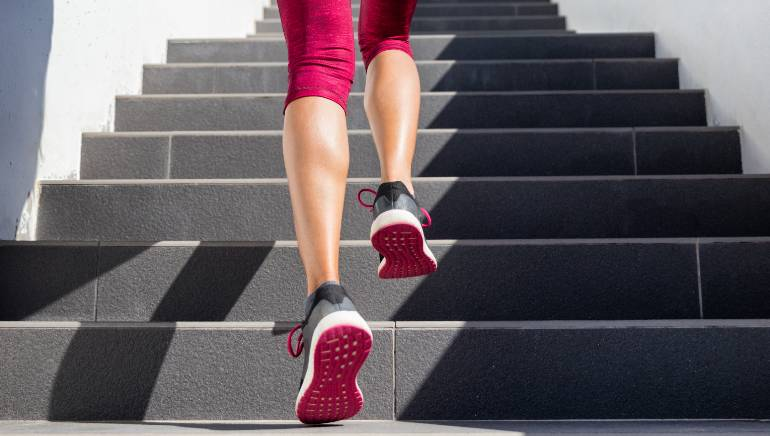Going up and down stairs has very positive repercussions on the health of those who dedicate a few minutes to this practice every day, but also for their pocket and the environment
Every movement counts towards better health. This phrase, from the World Health Organization (WHO), recognizes that all people, regardless of their age and abilities, can be physically active. Walking to school or work, doing housework vigorously (HIIPA), or running with your dog for a while during walks are small efforts that avoid falling into a sedentary lifestyle. Regarding a habit as simple as going up and down the stairs, it is known that just seven minutes a day of this exercise covers the recommended physical activity for a day. We tell you more about its benefits, which will surely encourage you to leave the elevator, the ramp, or the escalator.
Strengthens muscles
When using the stairs in our portal, work, subway or train, we use several muscles (legs, abdominals, back and arms) and joints (hips, knees, ankles). Specifically, this simple action helps to tone the muscles of the legs and buttocks.
But going upstairs is not the same as going downstairs. What is exercised by climbing stairs? The quadriceps, buttocks and calves are activated, while, going down, the quadriceps make more effort. With the work of these muscles, you will gain strength and prevent injuries. In fact, it helps reduce the risk of falls in older people.
Helps control obesity
Climbing stairs burns calories. How much weight do you lose climbing stairs? It is estimated that between 8 and 11 kilocalories are lost per minute. And an average of 0.1 calories is spent going up and 0.05 going down.
But there are studies, such as that of the University of Roehampton (United Kingdom), which have shown that to burn about 300 calories it would be necessary to climb five floors at a good pace for five days in a row. You have to do it without skipping steps, because if we do it two by two, we will spend less energy (206 kilocalories): less time is invested and the muscles do not work as much.
According to this research , the frequent use of stairs can contribute to the reduction of the body mass index (BMI). And it is that the scientists verified that using the stairs for 12 weeks has rapid repercussions on the BMI and the percentage of body fat, and to a lesser extent on weight, blood pressure, heart rate and strength in the muscles in the lower limbs.
On the other hand, on the rebound, by attacking the fat cells of the adipose tissue, climbing stairs helps your skin , since cellulite and orange peel skin on the thighs and abdomen are reduced.
Improves cardiac, respiratory and circulatory capacity
As it is an aerobic exercise, climbing stairs improves cardiovascular health, since it manages to reduce blood cholesterol levels and blood pressure . That is, it prevents cardiovascular diseases and other risk factors such as cholesterol or hypertension. In addition, it increases cardiorespiratory resistance if done at a light pace for five minutes. And stimulates circulation, which prevents the formation of varicose veins.
A piece of information: spending seven minutes a day climbing stairs reduces the incidence of cardiovascular disease in middle-aged men by almost two thirds. And another, the one pointed out by this study published in 2021 in the ‘ International Journal of Environmental Research and Public Health: “ People who comfortably go up and down the stairs at home reduce not only cardiovascular risks, but also risk factors of metabolic syndrome, such as triglycerides, fasting glucose, and cholesterol .”
Reduces the risk of type 2 diabetes
Exercise is essential for the treatment and prevention of diabetes . As the Spanish Society of Family and Community Medicine (semFYC) points out in its ‘ Practical Health Guide ‘, it stimulates blood circulation, improves heart performance, helps control blood glucose, allows weight loss, decreases blood pressure and cholesterol and produces physical and mental well-being. That is why he recommends doing daily aerobic exercise such as walking with a certain speed, dancing, swimming, running without getting too tired… and climbing stairs.
A recent study (2022) supports that a gesture as common as climbing stairs at a good pace reduces the risk of type 2 diabetes , especially among people with a low genetic predisposition to this disease . Research , carried out by a group of universities in China, Sweden and Australia over 12 years with the UK Biobank (United Kingdom) cohort, concludes that climbing stairs decreases this risk depending on the number of steps we ascend each day:
- if we climb between 10 and 50 stairs a day, the risk is reduced by 5%.
- if we climb between 60 and 100 stairs a day, the risk is reduced by 8%.
- if we climb between 110 and 150 stairs a day, the risk is reduced by 14% .
For the study authors, “these findings highlight that stair climbing, as incidental physical activity, offers a simple and low-cost adjunct to public health interventions for diabetes prevention.”
But not only is this practice good for preventing this type of diabetes, but it is also good for patients who already suffer from it. Another 2017 scientific work carried out in Japan suggests that the habitual exercise of going up and down stairs for three minutes after a meal may be a “promising method to improve postprandial glycemic control in people with type 2 diabetes.”
Extend life
It is estimated that climbing more than 55 flights of stairs a week significantly reduces the risk of dying, highlighted in the Hospital del Mar (Barcelona) with its campaign ‘ Escala les escales ‘ . Doing this activity for seven minutes reduces the risk of suffering a heart attack by 38% , as commented by the Generalitat de Catalunya . And spending ” 30 minutes a week increases cardiorespiratory fitness , an important healthy marker linked to longevity,” according to research from McMaster University (Canada).
Do you want to know if you are at higher risk of heart disease or cancer? Use the stairs. According to recent research from the University Hospital of A Coruña , if you are a healthy person you should not have any problem climbing four flights of stairs (60 steps) in less than a minute without stopping.
Strengthens the bones
It improves the absorption of calcium, thus reducing the risk of suffering from osteoporosis and, consequently, of having bone fractures. In addition, according to this study, there is a strong relationship between bone density and stair climbing in women after menopause.
Benefits mental and emotional health
Doing physical exercise is always good for the mind. During and after your practice, endorphins and serotonins (the happiness hormones) are released and you feel greater emotional well-being. It also helps reduce your stress (lowers blood cortisol) and increases your self-esteem, as well as improving performance and concentration.
Save time
According to a study published in the Canadian Medical Association Journal by researchers at a Canadian hospital, each time they had doctors take the stairs instead of taking the elevator, they saved 15 minutes of time. Think of all the time you spend waiting for the elevator, for the doors to open, close, go up, stop, and the doors open again (not counting more people going in or out on other floors).
Take care of the environment
You don’t need anything special to be able to practice this exercise, so it’s good for your pocket. But if you want to run upstairs —vertical running is a sport in which you compete by climbing emblematic skyscrapers such as the Empire State Building (New York, USA) or the Eiffel Tower (Paris, France)—, the ideal are good running shoes as additional equipment.
It is, therefore, an affordable, accessible, and sustainable physical activity, as it benefits the environment: it contributes to saving energy and reducing the ecological footprint. And it is that it is calculated that the consumption of an elevator that takes a single person from a ground floor to a third floor is equivalent to keeping a 20-watt electric light bulb on for 15 minutes.








